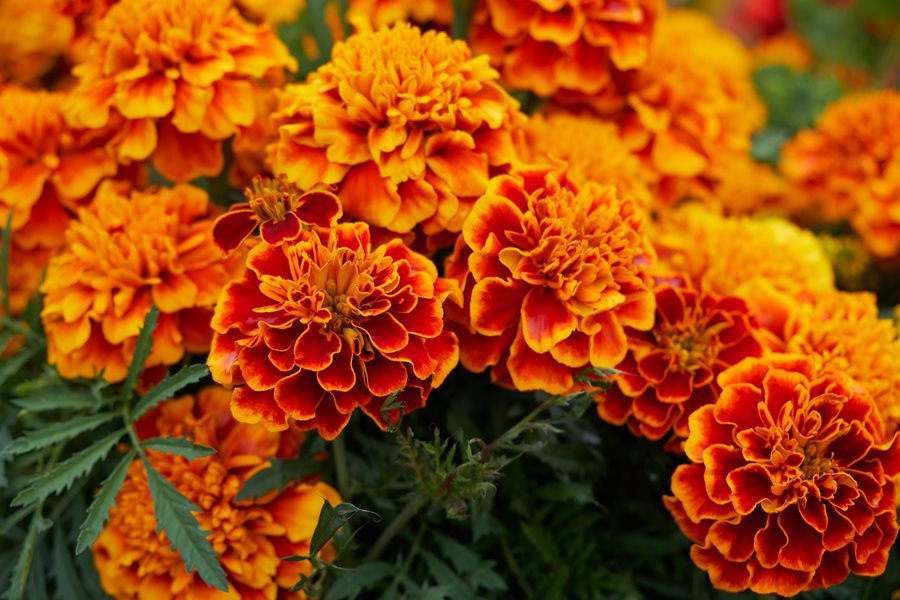Orange marigold are a popular and easy-to-grow annual flower that adds a bright pop of color to any garden or outdoor space. With their vibrant orange blooms and hardy nature, they are a favorite among gardeners of all skill levels. In this guide, we’ll cover everything you need to know to care for your orange marigold, from planting and watering to pruning and deadheading, as well as tips for identifying and treating common pests and diseases. Whether you’re a seasoned gardener or just starting out, you’ll find everything you need to know to keep your orange marigold healthy and vibrant all season long.
Choosing and Planting Orange Marigolds
Selecting the Right Variety of Orange Marigold
When choosing orange marigold, there are several varieties to consider. French marigold, for example, are smaller and more compact, making them ideal for borders or container gardens. African marigold, on the other hand, are larger and can grow up to three feet tall, making them a great choice for adding height and drama to your garden.
Preparing Soil and Planting Location
Once you’ve selected your orange marigold variety, it’s important to choose the right planting location. Marigolds thrive in well-drained soil and full sun, so choose a location that receives at least six hours of sunlight per day. Avoid planting marigolds in areas with standing water or heavy clay soil, as this can lead to root rot.
To prepare the soil, remove any weeds or debris and loosen the soil to a depth of at least six inches. If your soil is heavy or clay-like, consider adding organic matter such as compost or peat moss to improve drainage.
Planting Seeds or Seedlings
When planting orange marigolds, you can either start with seeds or seedlings. Seeds should be planted about 1/4 inch deep and spaced about 6-8 inches apart. Water the soil gently after planting to ensure the seeds are moist.
If you’re using seedlings, dig a hole that’s slightly larger than the root ball and place the seedling in the hole. Backfill the soil around the seedling and gently press down to ensure it’s secure. Water the soil gently after planting to help the seedling settle in.
By following these tips for selecting and planting orange marigolds, you can enjoy a vibrant and healthy garden full of these beautiful flowers. Remember to water regularly and fertilize as needed to keep your marigolds looking their best.
Watering and Fertilizing Orange Marigold
Watering Schedule and Techniques of orange marigold
Orange marigolds require regular watering to thrive, especially during hot and dry periods. Water your marigolds deeply once or twice a week, depending on the weather and soil conditions. Avoid overwatering, as this can lead to root rot and other fungal diseases.
To water your marigolds, use a hose or watering can to apply water directly to the soil, rather than spraying the leaves. This helps prevent fungal diseases and ensures the water reaches the roots where it’s needed most.
Importance of Proper Drainage
In addition to regular watering, proper drainage is essential for healthy orange marigolds. Make sure your planting location has well-drained soil, and avoid planting in areas with standing water or heavy clay soil.
If you’re growing marigolds in containers, make sure the pots have drainage holes and use a high-quality potting mix that’s designed for good drainage.
Fertilization Tips and Recommendations
Orange marigolds benefit from regular fertilization, especially during the growing season. Use a balanced fertilizer with equal parts nitrogen, phosphorus, and potassium, and apply according to the manufacturer’s instructions.
Avoid over-fertilizing, as this can lead to excessive foliage growth at the expense of flowers. Instead, use a slow-release fertilizer or apply a liquid fertilizer every two to three weeks during the growing season.
By following these tips for watering and fertilizing orange marigolds, you can ensure your plants are healthy and vibrant all season long. Remember to monitor soil moisture and adjust your watering schedule as needed, and always use high-quality fertilizers to provide your marigolds with the nutrients they need to thrive.
Pruning and Deadheading Orange Marigold
Importance of Pruning and Deadheading
Pruning and deadheading are important techniques for promoting healthy growth and blooming in orange marigolds. Pruning involves cutting back the foliage and stems of the plant, while deadheading involves removing spent flowers.
By pruning and deadheading regularly, you can encourage your marigolds to produce more flowers and maintain a compact and tidy appearance.
When to Prune and Deadhead
Pruning should be done early in the growing season, before the plant has begun to produce flowers. This helps promote bushier growth and more flowers later in the season.
Deadheading, on the other hand, should be done throughout the growing season as soon as the flowers begin to fade. This helps redirect the plant’s energy towards producing more flowers, rather than producing seeds.
Pruning and Deadheading Techniques
To prune your orange marigolds, use a pair of clean, sharp pruning shears to cut back the stems and foliage by about one-third. This helps promote bushier growth and more flowers.
To deadhead your marigolds, use your fingers or a pair of scissors to remove spent flowers as soon as they begin to fade. Cut the stem just above the first set of leaves to encourage new growth and blooming.
By following these tips for pruning and deadheading orange marigolds, you can enjoy a healthy and vibrant garden full of these beautiful flowers. Remember to prune and deadhead regularly throughout the growing season to promote healthy growth and blooming.
Common Pests and Diseases of Orange Marigold
Common Pests
Orange marigolds are relatively pest-resistant, but they can still be affected by a few common pests. Aphids, for example, are small insects that feed on the leaves and stems of the plant, causing yellowing and stunted growth. Spider mites are another common pest that can cause yellowing and webbing on the leaves.
To treat pest infestations, use a gentle insecticidal soap or neem oil spray. Apply according to the manufacturer’s instructions, and repeat as needed until the infestation is under control.
Common Diseases
Orange marigolds can also be affected by a few common diseases, such as powdery mildew and botrytis blight. Powdery mildew appears as a white, powdery coating on the leaves and stems, while botrytis blight causes brown spots and wilting.
To treat fungal diseases, remove any affected leaves or stems and dispose of them in the trash. Avoid watering the leaves of the plant, as this can promote fungal growth. Use a fungicidal spray according to the manufacturer’s instructions, and repeat as needed until the disease is under control.
Prevention Tips for Orange Marigold
Prevention is the best way to avoid pest and disease issues with your orange marigolds. Make sure your planting location has well-drained soil and receives plenty of sunlight. Avoid overcrowding your plants, as this can promote fungal growth and pest infestations.
Water your marigolds deeply and regularly, but avoid overwatering, as this can lead to root rot and other fungal diseases. Finally, monitor your plants regularly for signs of pests or diseases, and take action immediately to prevent further damage.
By following these tips for identifying and treating common pests and diseases, you can ensure your orange marigolds remain healthy and vibrant all season long. Remember to use gentle and natural treatments whenever possible, and always read and follow the manufacturer’s instructions carefully.
Conclusion
In conclusion, orange marigold are beautiful and relatively easy to care for plants. By following the tips outlined in this guide, you can ensure your marigolds remain healthy and vibrant all season long. Remember to water deeply and regularly, prune and deadhead regularly, and watch out for common pests and diseases. With a little bit of care and attention, your orange marigolds will reward you with a stunning display of flowers that will brighten up your garden or outdoor space.

















Leave a Reply